肢体语言1PPT课件
- 格式:ppt
- 大小:1.64 MB
- 文档页数:23
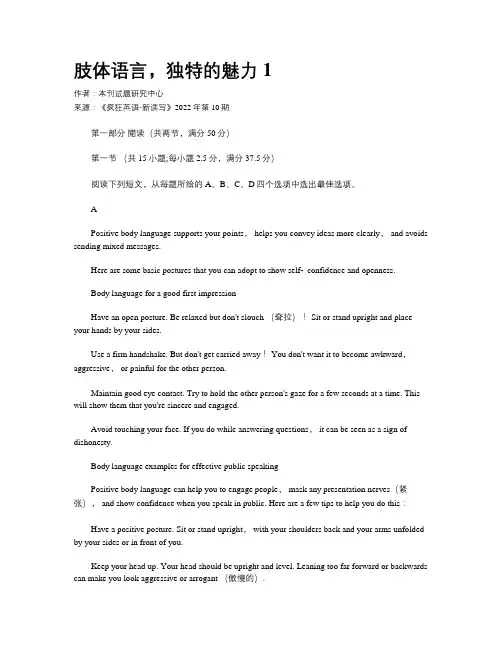
肢体语言,独特的魅力1作者:本刊试题研究中心来源:《疯狂英语·新读写》2022年第10期第一部分閱读(共两节,满分50分)第一节(共15小题;每小题2.5分,满分37.5分)阅读下列短文,从每题所给的A、B、C、D四个选项中选出最佳选项。
APositive body language supports your points, helps you convey ideas more clearly, and avoids sending mixed messages.Here are some basic postures that you can adopt to show self⁃confidence and openness.Body language for a good first impressionHave an open posture. Be relaxed but don't slouch (耷拉)! Sit or stand upright and place your hands by your sides.Use a firm handshake. But don't get carried away! You don't want it to become awkward,aggressive, or painful for the other person.Maintain good eye contact. Try to hold the other person's gaze for a few seconds at a time. This will show them that you're sincere and engaged.Avoid touching your face. If you do while answering questions, it can be seen as a sign of dishonesty.Body language examples for effective public speakingPositive body language can help you to engage people, mask any presentation nerves(紧张), and show confidence when you speak in public. Here are a few tips to help you do this:Have a positive posture. Sit or stand upright, with your shoulders back and your arms unfolded by your sides or in front of you.Keep your head up. Your head should be upright and level. Leaning too far forward or backwards can make you look aggressive or arrogant (傲慢的).Practice and perfect your posture. Stand in a relaxed manner, with your weight evenly distributed. Keep one foot slightly in front of the other to help hold your posture.Use open hand gestures. Spread your hands apart, in front of you, with your palmsfacing slightly towards your audience. This indicates a willingness to communicate and share ideas.1. What body language can be regarded as being dishonest?A. Having an open posture.B. Using a firm handshake.C. Maintaining good eye contact.D. Touching your face.2. What does the underlined word “mask” probably mean?A. Wear.B. Hide.C. Prevent.D. Show.3. How can you make public speaking effective?A. By sitting with arms folded.B. By leaning your head forward.C. By standing in an easy manner.D. By spreading your arms apart.BTeachers are having lessons in how to read children's body language and change their own to deal with bad behavior in the classroom. Thousands have been trained to watch pupils' gestures,mannerisms, facial expressions and speech to know what they are thinking and how they feel. They are encouraged to copy a child's gestures to give the child a message that the teacher understands him or her.For example, if a child is talking with his left hand touching his chin (下巴), teachers should stand and hold their left hand to touch their chin. Teachers are also taught to avoid “closed” signals such as folded arms or standing behind a desk. The training is part of a set of exercises called neuronlinguistic programming (NLP) which is designed to improve communication and patterns of behavior.NLP was developed in the 1970s at the University of California in the US. Currently, its methods have been employed in a variety of fields, including sales and marketing. In the UK, at least 50 companies now offer courses in NLP, many aimed at teachers. More than1,200 teachers in England have received training in NLP. Hundreds of schools also pay thousands of pounds for the training.Supporters of the application of the technology to teaching pupils claim it is a new way to deal with poor behavior in the classroom. In their eyes, since matching body language means looking at the world through the young persons' eyes, it can improve children's behavior in the classroom and motivate them to learn.However, critics say that NLP is simply an educational fashion that is actually destroying teachers' good teaching. Frank, a sociology professor at the University of Kent, says,“What NLP means is that teachers must learn to get cues (暗示) from children, which is the opposite of what students get from teachers. Every few years there's a big idea that becomes the theme in education. They are tricks and will be replaced w ith the next big thing.”4. What is the purpose of teacher training according to paragraph 1?A. To learn how to please the students.B. To teach them how to control students.C. To improve their classroom management.D. To make their later classes more enjoyable.5. What ability is important when teachers use NLP in teaching?A. Imitation.B. Survey.C. Analysis.D. Judgment.6. What does Frank think of the use of NLP in education?A. It is like going against the tide.B. It has an impact on respect for teachers.C. It will be washed out by the tide of the times.D. It is the same as going the old way with new shoes.7. What is the author's attitude to the use of NLP in education?A. Concerned.B. Supportive.C. Unclear.D. Objective.CI met Ariep on an island in the South Pacific nation of Vanuatu. Being the last fluent Naati speaker in the area, he sadly expressed his fear that, with his death, the language would disappear.For example, if a child is talking with his left hand touching his chin (下巴), teachers should stand and hold their left hand to touch their chin. Teachers are also taught to avoid “closed” signals such as folded arms or standing behind a desk. The training is part of a set of exercises called neuronlinguistic programming (NLP) which is designed to improve communication and patterns of behavior.NLP was developed in the 1970s at the University of California in the US. Currently, its methods have been employed in a variety of fields, including sales and marketing. In the UK, at least 50 companies now offer courses in NLP, many aimed at teachers. More than1,200 teachers in England have received training in NLP. Hundreds of schools also pay thousands of pounds for the training.Supporters of the application of the technology to teaching pupils claim it is a new way to deal with poor behavior in the classroom. In their eyes, since matching body language means looking at the world through the young persons' eyes, it can improve children's behavior in the classroom and motivate them to learn.However, critics say that NLP is simply an educational fashion that is actually destroying teachers' good teaching. Frank, a sociology professor at the University of Kent, says,“What NLP means is that teachers must learn to get cues (暗示) from children, which is the opposite of what students get from teachers. Every few years there's a big idea that becomes the theme in education. They are tricks and will be replaced with the next big thing.”4. What is the purpose of teacher training according to paragraph 1?A. To learn how to please the students.B. To teach them how to control students.C. To improve their classroom management.D. To make their later classes more enjoyable.5. What ability is important when teachers use NLP in teaching?A. Imitation.B. Survey.C. Analysis.D. Judgment.6. What does Frank think of the use of NLP in education?A. It is like going against the tide.B. It has an impact on respect for teachers.C. It will be washed out by the tide of the times.D. It is the same as going the old way with new shoes.7. What is the author's attitude to the use of NLP in education?A. Concerned.B. Supportive.C. Unclear.D. Objective.CI met Ariep on an island in the South Pacific nation of Vanuatu. Being the last fluent Naati speaker in the area, he sadly expressed his fear that, with his death, the language would disappear.For example, if a child is talking with his left hand touching his chin (下巴), teachers should stand and hold their left hand to touch their chin. Teachers are also taught to avoid “closed” signals such as folded arms or standing behind a desk. The training is part of a set of exercises called neuronlinguistic programming (NLP) which is designed to improve communication and patterns of behavior.NLP was developed in the 1970s at the University of California in the US. Currently, its methods have been employed in a variety of fields, including sales and marketing. In the UK, at least 50 companies now offer courses in NLP, many aimed at teachers. More than1,200 teachers in England have received training in NLP. Hundreds of schools also pay thousands of pounds for the training.Supporters of the application of the technology to teaching pupils claim it is a new way to deal with poor behavior in the classroom. In their eyes, since matching body language means looking at the world through the young persons' eyes, it can improve children's behavior in the classroom and motivate them to learn.However, critics say that NLP is simply an educational fashion that is actually destroying teachers' good teaching. Frank, a sociology professor at the University of Kent, says,“What NLP means is that teachers must learn to get cues (暗示) from children, which is the opposite of whatstudents get from teachers. Every few years there's a big idea that becomes the theme in education. They are tricks and will be replaced with the next big thing.”4. What is the purpose of teacher training according to paragraph 1?A. To learn how to please the students.B. To teach them how to control students.C. To improve their classroom management.D. To make their later classes more enjoyable.5. What ability is important when teachers use NLP in teaching?A. Imitation.B. Survey.C. Analysis.D. Judgment.6. What does Frank think of the use of NLP in education?A. It is like going against the tide.B. It has an impact on respect for teachers.C. It will be washed out by the tide of the times.D. It is the same as going the old way with new shoes.7. What is the author's attitude to the use of NLP in education?A. Concerned.B. Supportive.C. Unclear.D. Objective.CI met Ariep on an island in the South Pacific nation of Vanuatu. Being the last fluent Naati speaker in the area, he sadly expressed his fear that, with his death, the language would disappear.For example, if a child is talking with his left hand touching his chin (下巴), teachers should stand and hold their left hand to touch their chin. Teachers are also taught to avoid “closed” signals such as folded arms or standing behind a desk. The training is part of a set of exercises called neuronlinguistic programming (NLP) which is designed to improve communication and patterns of behavior.NLP was developed in the 1970s at the University of California in the US. Currently, its methods have been employed in a variety of fields, including sales and marketing. In the UK, at least 50 companies now offer courses in NLP, many aimed at teachers. More than1,200 teachers in England have received training in NLP. Hundreds of schools also pay thousands of pounds for the training.Supporters of the application of the technology to teaching pupils claim it is a new way to deal with poor behavior in the classroom. In their eyes, since matching body language means looking at the world through the young persons' eyes, it can improve children's behavior in the classroom and motivate them to learn.However, critics say that NLP is simply an educational fashion that is actually destroying teachers' good teaching. Frank, a sociology professor at the University of Kent, says,“What NLP means is that teachers must learn to get cues (暗示) from children, which is the opposite of what students get from teachers. Every few years there's a big idea that becomes the theme in education. They are tricks and will be replaced with the next big thing.”4. What is the purpose of teacher training according to paragraph 1?A. To learn how to please the students.B. To teach them how to control students.C. To improve their classroom management.D. To make their later classes more enjoyable.5. What ability is important when teachers use NLP in teaching?A. Imitation.B. Survey.C. Analysis.D. Judgment.6. What does Frank think of the use of NLP in education?A. It is like going against the tide.B. It has an impact on respect for teachers.C. It will be washed out by the tide of the times.D. It is the same as going the old way with new shoes.7. What is the author's attitude to the use of NLP in education?A. Concerned.B. Supportive.C. Unclear.D. Objective.CI met Ariep on an island in the South Pacific nation of Vanuatu. Being the last fluent Naati speaker in the area, he sadly expressed his fear that, with his death, the language would disappear.For example, if a child is talking with his left hand touching his chin (下巴), teachers should stand and hold their left hand to touch their chin. Teachers are also taught to avoid “closed” signals such as folded arms or standing behind a desk. The training is part of a set of exercises called neuronlinguistic programming (NLP) which is designed to improve communication and patterns of behavior.NLP was developed in the 1970s at the University of California in the US. Currently, its methods have been employed in a variety of fields, including sales and marketing. In the UK, at least 50 companies now offer courses in NLP, many aimed at teachers. More than1,200 teachers in England have received training in NLP. Hundreds of schools also pay thousands of pounds for the training.Supporters of the application of the technology to teaching pupils claim it is a new way to deal with poor behavior in the classroom. In their eyes, since matching body language means looking at the world through the young persons' eyes, it can improve children's behavior in the classroom and motivate them to learn.However, critics say that NLP is simply an educational fashion that is actually destroying teachers' good teaching. Frank, a sociology professor at the University of Kent, says,“What NLP means is that teachers must learn to get cues (暗示) from children, which is the opposite of what students get from teachers. Every few years there's a big idea that becomes the theme in education. They are tricks and will be replaced with the next big thing.”4. What is the purpose of teacher training according to paragraph 1?A. To learn how to please the students.B. To teach them how to control students.C. To improve their classroom management.D. To make their later classes more enjoyable.5. What ability is important when teachers use NLP in teaching?A. Imitation.B. Survey.C. Analysis.D. Judgment.6. What does Frank think of the use of NLP in education?A. It is like going against the tide.B. It has an impact on respect for teachers.C. It will be washed out by the tide of the times.D. It is the same as going the old way with new shoes.7. What is the author's attitude to the use of NLP in education?A. Concerned.B. Supportive.C. Unclear.D. Objective.CI met Ariep on an island in the South Pacific nation of Vanuatu. Being the last fluent Naati speaker in the area, he sadly expressed his fear that, with his death, the language would disappear.For example, if a child is talking with his left hand touching his chin (下巴), teachers should stand and hold their left hand to touch thei r chin. Teachers are also taught to avoid “closed” signals such as folded arms or standing behind a desk. The training is part of a set of exercises called neuronlinguistic programming (NLP) which is designed to improve communication and patterns of behavior.NLP was developed in the 1970s at the University of California in the US. Currently, its methods have been employed in a variety of fields, including sales and marketing. In the UK, at least 50 companies now offer courses in NLP, many aimed at teachers. More than1,200 teachers in England have received training in NLP. Hundreds of schools also pay thousands of pounds for the training.Supporters of the application of the technology to teaching pupils claim it is a new way to deal with poor behavior in the classroom. In their eyes, since matching body language means looking at the world through the young persons' eyes, it can improve children's behavior in the classroom and motivate them to learn.However, critics say that NLP is simply an educational fashion that is actually destroying teachers' good teaching. Frank, a sociology professor at the University of Kent, says,“What NLP means is that teachers must learn to get cues (暗示) from children, which is the opposite of what students get from teachers. Every few years there's a big idea that becomes the theme in education. They are tricks and will be replaced with the next big thing.”4. What is the purpose of teacher training according to paragraph 1?A. To learn how to please the students.B. To teach them how to control students.C. To improve their classroom management.D. To make their later classes more enjoyable.5. What ability is important when teachers use NLP in teaching?A. Imitation.B. Survey.C. Analysis.D. Judgment.6. What does Frank think of the use of NLP in education?A. It is like going against the tide.B. It has an impact on respect for teachers.C. It will be washed out by the tide of the times.D. It is the same as going the old way with new shoes.7. What is the author's attitude to the use of NLP in education?A. Concerned.B. Supportive.C. Unclear.D. Objective.CI met Ariep on an island in the South Pacific nation of Vanuatu. Being the last fluent Naati speaker in the area, he sadly expressed his fear that, with his death, the language would disappear.For example, if a child is talking with his left hand touching his chin (下巴), teachers should stand and hold their left hand to touch their chin. Teachers are also taught to avoid “closed” signals such as folded arms or standing behind a desk. The training is part of a set of exercises calledneuronlinguistic programming (NLP) which is designed to improve communication and patterns of behavior.NLP was developed in the 1970s at the University of California in the US. Currently, its methods have been employed in a variety of fields, including sales and marketing. In the UK, at least 50 companies now offer courses in NLP, many aimed at teachers. More than1,200 teachers in England have received training in NLP. Hundreds of schools also pay thousands of pounds for the training.Supporters of the application of the technology to teaching pupils claim it is a new way to deal with poor behavior in the classroom. In their eyes, since matching body language means looking at the world through the young persons' eyes, it can improve children's behavior in the classroom and motivate them to learn.However, critics say that NLP is simply an educational fashion that is actually destroying teachers' good teaching. Frank, a sociology professor at the University of Kent, says,“What NLP means is that teachers must learn to get cues (暗示) from children, which is the opposite of what students get from teachers. Every few years there's a big idea that becomes the theme in education. They are tricks and will be replaced with the next big thing.”4. What is the purpose of teacher training according to paragraph 1?A. To learn how to please the students.B. To teach them how to control students.C. To improve their classroom management.D. To make their later classes more enjoyable.5. What ability is important when teachers use NLP in teaching?A. Imitation.B. Survey.C. Analysis.D. Judgment.6. What does Frank think of the use of NLP in education?A. It is like going against the tide.B. It has an impact on respect for teachers.C. It will be washed out by the tide of the times.D. It is the same as going the old way with new shoes.7. What is the author's attitude to the use of NLP in education?A. Concerned.B. Supportive.C. Unclear.D. Objective.CI met Ariep on an island in the South Pacific nation of Vanuatu. Being the last fluent Naati speaker in the area, he sadly expressed his fear that, with his death, the language would disappear.。

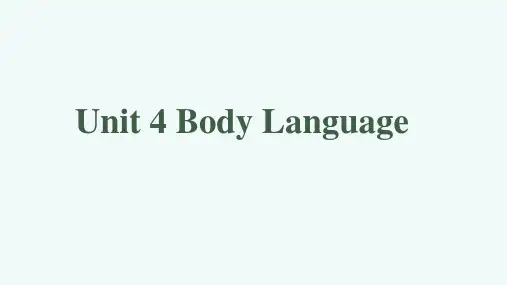

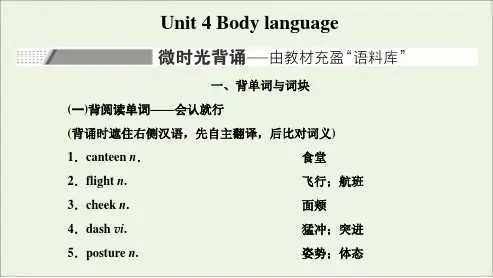
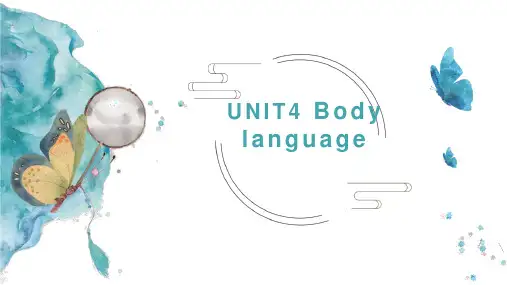

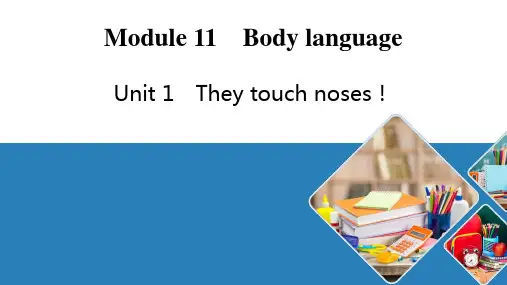
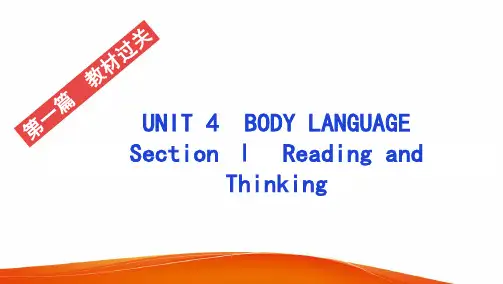
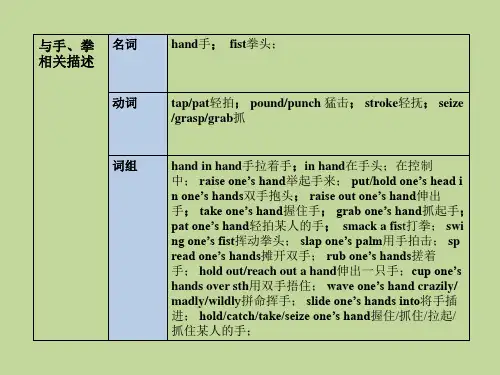

肢体语言整理头部运作:抬头:自信/骄傲/思考歪头:好奇/挑逗低头:难过/垂头尚气/平静身体:单边耸肩:不确定/有所隐藏/不懂的轻微版单边肩膀轻微抬起(比如一个人不喜欢的人在他的左边,他会轻轻抬起他的左肩):不喜欢身体向前倾:感兴趣/要接近目标/胸有成竹身体向后倾:不感兴趣/要离开目标/不喜欢这种情境或场面身体弯曲:难过/失落/不自信身体挺直:自信/胸有成竹轻微把背对着人:要离开那个人/不喜欢那个人手:双手放松:自在/不受约束/没有任何正面或负面看法双手打开:心也打开了/接受对方/不觉得对方有敌意/像亲近对方双手交叉:防御性手势/充满敌意/远离对象双手握拳交叉:比单单交叉更具敌意/证明负面意见不改双手放在头后面(弹弓式手势):自信/骄傲(女生很接受不了男生这个动作。
)双手叉腰:权威/恐吓/争斗双手放在私处前:不自信/不安全感/礼貌/低声下气掩饰性手部防御动作:双手在腰前捧着鲜花/咖啡/书包手在腰前整理袖口手在腰前弄手表类似的动作。
双手身后:手掌抓手掌:自信/权威手掌抓手腕:轻微紧张/轻微焦虑手掌抓手臂:非常紧张/非常焦虑双手脸部:(手触碰)单手支撑头部:无趣/无聊/没兴趣手放在下巴:批判/批评/思考(如果加低头的话就比较可能是负面想法,抬头就相反)手放在嘴部:非礼勿说/隐藏/批判手放在眼睛:非礼勿看/不赞同/隐藏手放在耳朵:非礼勿听/不赞同/隐藏手放在鼻子:隐藏/拥有情绪(可是不知道是什么情绪)摸颈子:累、紧张、焦虑、担忧、不安、无聊、颈子酸痛、尴尬、害羞脚:4字形交叉:放松/自在/防御叠起来交叉:防御/自信/放松/自在交叉时上面的脚指着的人:非常可能是他(或她)喜欢她(或他)双脚打开:恐吓/权威/占领地盘/放松/自在双脚摇摆:快乐脚/感觉到开心/自信脚的方向:(不一定是)他想去的地方/他喜欢的人/他的目标背离地心引力的动作:背离地心引力的动作其实就是做出与地上相反方向的动作眉毛抬起:轻微高兴/惊讶嘴角拉起:高兴肩膀抬起:轻微高兴/觉得轻松/自在/清爽用脚根支撑身体并把脚尖抬高:高兴/开心/听到好消息/遇见喜欢的人用脚尖支撑身体并把脚跟抬高:(一样)负担肢体语言肩膀放下/头垂下/眼睛看下/手放下/驼背/总结:全身无力表示无力感、失望、无奈、悲伤、觉得自己失败。
课题选必一Unit 4 Body Language 复习课教学设计新授课□章/单元复习课☑专题复习课□课型习题/试卷讲评课□学科实践活动课□其他□1.教学内容分析本单元的话题为肢体语言,属于人与社会主题下的社会服务与人际沟通范围,是学生熟悉且感兴趣的话题。
本单元复习课由三节课完成,分别为第1节,主题语境下动词-ing的巩固复习;第2节,主题语境下词汇短语的巩固及运用;第3节,主题语境下的综合写作课。
本节课为单元复习课第2节,旨在围绕肢体语言这一主题,从跨文化中人类肢体语言的相通性的角度进行课文短语,肢体语言描述等相关内容的复习,帮助学生巩固已学知识并进行综合运用,培养学生成为良好沟通者的意识。
2.学习者分析本课授课对象为高三(17)班学生,共54人,选科方向为物化生。
大部分学生对英语感兴趣,学习态度认真,课堂能积极配合。
学生已掌握关于肢体语言的相关知识,但在语言运用方面能力还较薄弱,比如,如何通过准确描述人物的面部表情和肢体动作来表达人物的相关情绪。
其次,学生能了解不同文化中一些通用的肢体语言的意义,但对于如何才能成为更好的沟通者的认识仍不到位。
3.学习目标确定语言能力方面:掌握与肢体语言相关的词汇,短语。
能描述各种肢体语言并辨析其所传达的人物情绪。
思维品质方面:围绕肢体语言,整合相关词汇与表达。
能在日常生活中识别他人的肢体语言,更好地与他人沟通交往。
文化意识方面:了解肢体语言在不同文化当中有差异也有通用性,培养跨文化意识。
学习能力方面:自主学习与合作学习相结合,丰富学习策略。
4.学习重点难点分析引导学生从多种角度描写人物肢体语言,体现人物所要表达的情绪。
能够将所学到的表达运用到场景描写当中。
5.教学方法与学法指导Activity-based Teaching, Individual Study and Cooperative Study6.教学资源:多媒体课件,一体机,白板7. 学习活动设计教师活动学生活动环节一:Lead-in教师活动1Greet the students and raise a question “What is the most popular and heated sports event these days?”Present a short video of the football players’ celebration after a goal.学生活动1Watch the video and describe how the players celebrate their goal.活动意图说明:用卡塔尔世界杯引入本单元话题,引起学生兴趣。